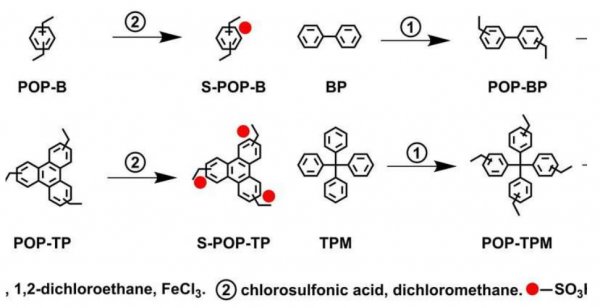
(Source: phys.org)
According to foreign media reports, researchers from Japan Institute of Advanced Science and Technology (JAIST) and Dalian Institute of Chemical Physics, Chinese Academy of Sciences have successfully developed a general synthetic design that uses porous organic polymers (POP) for fuel cell electrolytes.
The development of cost-effective new materials is an urgent need to achieve sustainable social development. In order to protect the environment, a clean energy system is indispensable. Among them, polymer electrolyte fuel cells have attracted much attention. Such batteries must be able to decompose a hydrogen molecule into positively charged protons and negatively charged electrons. To this end, a polymer material with high proton conductivity is required. Only protons are allowed to pass through the material, and no electrons are allowed to pass through, thereby generating electric current.
As shown in Scheme 1 in the figure, research shows that this synthesis method is simple, versatile, cost-effective, and can obtain a POP polymer with high proton conductivity. They show excellent proton conductivity of 10-2~10-1S/cm.
JAIST materials scientist Yuki Nagao said: "There are several problems in the current research, such as complex synthesis methods of POP polymers and limited frameworks. In order to develop general synthetic strategies suitable for practical applications, we try to use various frameworks as POP polymers. And to introduce almost all synthetic methods for aromatic hydrocarbon-based materials."
The researchers divided the synthesis step into two steps. First, a POP polymer is synthesized. Then, a post-sulfonation method is used to introduce sulfonic acid groups through the pores. The catalyst used in the synthesis will cause material degradation during the operation of the fuel cell, but it can be removed through the pores. Under the conditions of 95% RH and temperatures of 25°C and 80°C, respectively, S-POP-TPM exhibited excellent electrical conductivity of 2.7×10-2S/cm and 1.0×10-1S/cm, respectively.
Lead researcher Zhongping Li said: "The results of the study show that the structure of sulfonated POP polymers provides a simple and universal method for the development of structural designs of high-proton conductive materials." This work means that we A step forward. (Elisha)
Smart Appliances,Smart Home Appliance,Mini Smart Kitchen Appliance,Smart System Home Appliance
ChangChun E-vida Technology Co.,ltd , https://www.evidatech.com